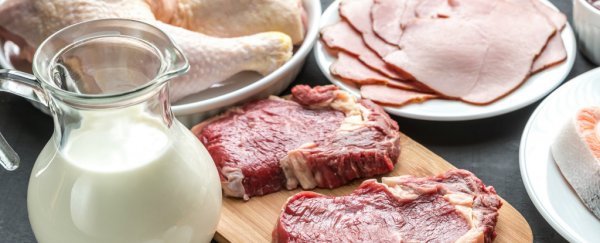While the number of organic products on our supermarket shelves has been rapidly increasing over the past decade, scientists have found that organically grown fruits and vegetables aren't all that different in terms of nutritional content when compared to regular ones, and they're definitely not 'packed with more nutrients', as many of us have been led to believe.
But now a review of more than 200 scientific papers has found that there are actually some differences when it comes to organic and non-organic milk and meat products. In fact, the results show that organic milk and meat products contain around 50 percent more omega-3 fatty acids than non-organic products. But - and this is a big but - while that sounds like a lot, according to experts, it's not enough to make an overall difference in your dietary intake. And the change is a result of the way animals are reared, not necessarily the fact that they were 'organic' and therefore weren't exposed to pesticides or fertiliser.
There are a whole lot of reasons to be 'for' or 'against' organic products, and there's no doubt that this is a contentious issue for a lot of people. But regardless of where you stand, it's important to know exactly what you're spending your money on, and this was the motivation behind the review.
"People choose organic milk and meat for three main reasons: improved animal welfare, the positive impacts of organic farming on the environment, and the perceived health benefits," said lead researcher Carlo Leifert from Newcastle University in the UK. "But much less is known about impacts on nutritional quality, hence the need for this study."
To figure this out, the team analysed 170 peer-reviewed papers on a range of animal milk products (including cheese and butter) and 67 papers on different meats - the largest study of its kind. The results have been published across two papers in the British Journal of Nutrition (here and here).
They found that organic meat contained on average 47 percent more omega-3 fatty acids than conventional meat, while organic milk products had on average 56 percent more. But despite the increase in omega-3s, the organic products weren't found to have higher fat content overall, which suggests that they have a more favourable ratio of good to bad fats.
"Omega-3s are linked to reductions in cardiovascular disease, improved neurological development and function, and better immune function," said one of the researchers, Chris Seal. The organic products were also found to have higher levels of vitamin E and carotenoids.
But it wasn't all good news - the organic milk and meat also contained 74 percent less iodine than the conventional products, which is an issue, seeing as animal products are a leading dietary source of iodine.
"Since milk is the greatest single source of dietary iodine, the lower value in organic milk needs to be recognised," Ian Givens, a professor of nutrition at the University of Reading, who wasn't involved in the research, told the Science Media Centre. "This is especially true for pregnant women, for whom iodine is a critical nutrient to ensure the healthy development of their baby."
More importantly, Givens argues that the difference in omega-3 (or n-3) fatty acids in the organic milk and meat products isn't as big a deal as the Newcastle team has made it out to be.
"Much emphasis is placed on the 56 percent higher n-3 fatty acid content of the organic milk," says Givens, "but this increase is in the milk fat, not in the whole milk. The effect also needs to be assessed in the whole diet."
"On average we consume about 2.2 g of n-3 fatty acids per day. Switching from conventional to organic milk would increase n-3 intake by about 33 mg per day – an increase of only 1.5 percent in our total diet," he added. "Such small changes are unlikely to represent any nutritional or health benefit."
At the same time, switching to organic milk would provide 14 percent less of the adult daily iodine requirement. Based on these calculations, Givens argues that the nutritional benefits of inorganic actually outweigh the benefits of organic.
So what's behind all these nutritional differences anyway? While the review didn't look into the exact cause, based on earlier studies, the researchers suggest it's a result of how the organic animals were reared, and the amount of grass they eat.
Givens agrees with that conclusion, but there's a big red flag we have to wave here - those production values aren't limited to organic products, which are defined solely by the fact that they're grown without fertilisers or pesticides.
"Differences in content such as fatty acids or iodine occur primarily because organic animals are fed more of a forage-based diet, such as grass, than their non-organic counterparts," explains Givens. "You get the same kind of changes in food composition if non-organic animals are fed forage-rich diets too. It's the choice of feed, not the organic farming method, which makes the difference."
So, in theory, you could choose regular grass-fed meat or milk to get the same omega-3 benefits, while avoiding the organic price tag. Or, if organic is your thing, that's fine too, but make sure you know what you're getting from a nutritional perspective before you buy.
"Overall, this is very detailed and valuable work, but the differences between organic and conventionally farmed produce should be evaluated as part of the whole human diet," said Givens. "When they are, most differences are very small indeed."
